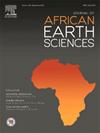A ∼6,600 year history of vegetation changes and sediment infill of the Moulay Bousselham Lagoon, Atlantic Morocco
IF 2.2
4区 地球科学
Q2 GEOSCIENCES, MULTIDISCIPLINARY
引用次数: 0
Abstract
The Moulay Bousselham Lagoon, composed of two parts, Merja Kahla and Merja Zerga, is one of the largest tidal lagoons on the Atlantic coast of NW Africa. Designated as a Ramsar Site, the Moulay Bousselham Lagoon has been identified as a significant carbon sink. Our research aims are to reconstruct regional vegetation changes and lagoonal infill history. The sedimentary infill was studied using three 3–3.5 m long cores dating to the Middle and Late Holocene. The main palaeoenvironmental proxies included sedimentology, foraminiferal analysis and palynology.
Apart from a basal sandy unit and a later and likely short-lived one, the lagoonal deposits mainly consist of sandy muds with about 10 % organic matter. Our results reveal an environmental transformation from an open lagoon to a restricted one at c. 6600-6100 cal yr BP, coinciding with rising global sea level. While in Merja Zerga grass meadows developed, Merja Kahla, closer to the inlet, was covered by salt marshes. The location of this coastal lagoon remained relatively stable since then, as reshaping is limited by an uplifting barrier consisting of a resistant calcarenite ridge. The Drader River and, since 1953 the Nador Canal, contribute sediment to the lagoon. Sedimentation rates range from 0.01 to 0.09 cm/yr, with a recent ten-fold increase mostly owing to enhanced anthropogenic erosion in the catchments. Despite this, the accommodation space is maintained due to tectonic subsidence along the lagoonal basin and the lower stretch of the river, and the role of carbon sink increases over time.
The reconstructed vegetation history indicates a decline of the cork oak forest. An ancient human presence is recorded dating back to at least the Neolithic period and suggests the likelihood of ancient Olea usage. This contrasts with much later modifications in vegetation cover in the nearby Rif Mountains.
求助全文
约1分钟内获得全文
求助全文
来源期刊

Journal of African Earth Sciences
地学-地球科学综合
CiteScore
4.70
自引率
4.30%
发文量
240
审稿时长
12 months
期刊介绍:
The Journal of African Earth Sciences sees itself as the prime geological journal for all aspects of the Earth Sciences about the African plate. Papers dealing with peripheral areas are welcome if they demonstrate a tight link with Africa.
The Journal publishes high quality, peer-reviewed scientific papers. It is devoted primarily to research papers but short communications relating to new developments of broad interest, reviews and book reviews will also be considered. Papers must have international appeal and should present work of more regional than local significance and dealing with well identified and justified scientific questions. Specialised technical papers, analytical or exploration reports must be avoided. Papers on applied geology should preferably be linked to such core disciplines and must be addressed to a more general geoscientific audience.
 求助内容:
求助内容: 应助结果提醒方式:
应助结果提醒方式:


